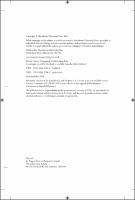Chapter 3 Mending “Moors” in Mogador
Hajj, cholera and Spanish-Moroccan regeneration, 1890–99
| dc.contributor.author | Javier Martinez, Francisco | |
| dc.date.accessioned | 2019-12-03 08:32:13 | |
| dc.date.accessioned | 2020-04-01T13:00:05Z | |
| dc.date.accessioned | 2018-03-16 23:55 | |
| dc.date.accessioned | 2019-12-03 08:32:13 | |
| dc.date.accessioned | 2020-04-01T13:00:05Z | |
| dc.date.accessioned | 2018-02-01 23:55:55 | |
| dc.date.accessioned | 2019-12-03 08:32:13 | |
| dc.date.accessioned | 2020-04-01T13:00:05Z | |
| dc.date.available | 2020-04-01T13:00:05Z | |
| dc.date.issued | 2018 | |
| dc.identifier | 645501 | |
| dc.identifier | OCN: 1030818687 | en_US |
| dc.identifier.uri | http://library.oapen.org/handle/20.500.12657/30520 | |
| dc.description.abstract | This chapter deals with a rather unknown quarantine institution: the lazaretto of Mogador Island in Morocco. Specifically, the work explores the site’s centrality to the Spanish imperialist project of “regeneration” over of its southern neighbour. In contrast with the “civilisation” schemes deployed by the leading European imperial powers at the end of the nineteenth century, regeneration did not seek to construct a colonial Morocco but a so-called African Spain in more balanced terms with peninsular Spain. This project was to be achieved through the support and direction of ongoing Moroccan initiatives of modernisation, as well as through the training of an elite of “Moors” who were to collaborate with Spanish experts sent to the country, largely based in Tangier. Within this general context, the Mogador Island lazaretto became a key site of regeneration projects. From a sanitary and political point of view, it was meant to define a Spanish-Moroccan space by marking its new borders and also to protect “Moorish” pilgrims against both the ideological and health-related risks associated with the Mecca pilgrimage. | |
| dc.language | English | |
| dc.relation.ispartofseries | Social Histories of Medicine | |
| dc.subject.classification | thema EDItEUR::N History and Archaeology::NH History::NHD European history | en_US |
| dc.subject.classification | thema EDItEUR::N History and Archaeology | en_US |
| dc.subject.classification | thema EDItEUR::3 Time period qualifiers::3M c 1500 onwards to present day | en_US |
| dc.subject.classification | thema EDItEUR::N History and Archaeology::NH History::NHT History: specific events and topics::NHTB Social and cultural history | en_US |
| dc.subject.classification | thema EDItEUR::J Society and Social Sciences | en_US |
| dc.subject.classification | thema EDItEUR::M Medicine and Nursing::MB Medicine: general issues::MBX History of medicine | en_US |
| dc.subject.other | hajj | |
| dc.subject.other | mogador island lazaretto | |
| dc.subject.other | 19th century | |
| dc.subject.other | moors | |
| dc.subject.other | spanish-moroccan relations | |
| dc.subject.other | regeneration | |
| dc.subject.other | hajj | |
| dc.subject.other | mogador island lazaretto | |
| dc.subject.other | 19th century | |
| dc.subject.other | moors | |
| dc.subject.other | spanish-moroccan relations | |
| dc.subject.other | regeneration | |
| dc.subject.other | Cholera | |
| dc.subject.other | Essaouira | |
| dc.subject.other | Mecca | |
| dc.subject.other | Quarantine | |
| dc.subject.other | Spain | |
| dc.subject.other | Tangier | |
| dc.title | Chapter 3 Mending “Moors” in Mogador | |
| dc.title.alternative | Hajj, cholera and Spanish-Moroccan regeneration, 1890–99 | |
| dc.type | chapter | |
| oapen.relation.isPublishedBy | 6110b9b4-ba84-42ad-a0d8-f8d877957cdd | |
| oapen.relation.isPartOfBook | ae4b9ba0-b880-4211-b6eb-198051cbc0e9 | |
| oapen.relation.isFundedBy | 47e70af6-bbda-4cd8-ad71-d6e1f5e435ef | |
| oapen.collection | EU collection | * |
| oapen.pages | 41 | |
| oapen.chapternumber | 3 | |
| oapen.remark.public | Relevant Wikipedia pages: Cholera - https://en.wikipedia.org/wiki/Cholera; Essaouira - https://en.wikipedia.org/wiki/Essaouira; Hajj - https://en.wikipedia.org/wiki/Hajj; Lazaretto - https://en.wikipedia.org/wiki/Lazaretto; Mecca - https://en.wikipedia.org/wiki/Mecca; Moors - https://en.wikipedia.org/wiki/Moors; Morocco - https://en.wikipedia.org/wiki/Morocco; Quarantine - https://en.wikipedia.org/wiki/Quarantine; Spain - https://en.wikipedia.org/wiki/Spain; Tangier - https://en.wikipedia.org/wiki/Tangier | |
| oapen.remark.public | 3-8-2020 - No DOI registered in CrossRef for ISBN 9781526127365 | |
| oapen.identifier.ocn | 1030818687 |

